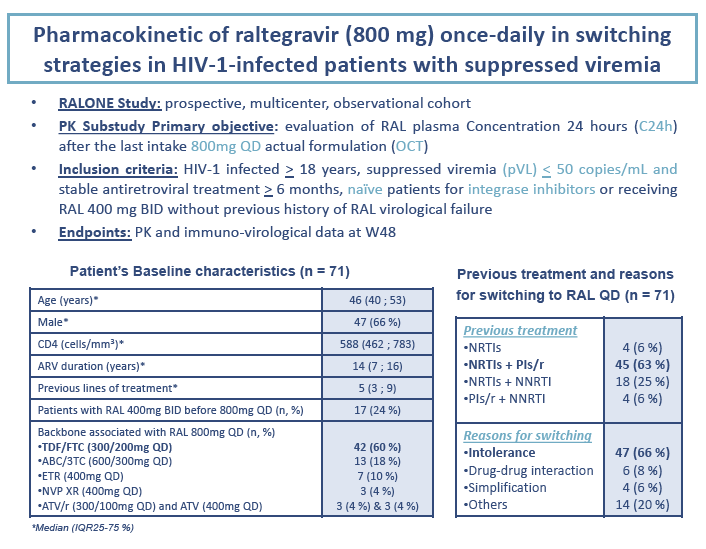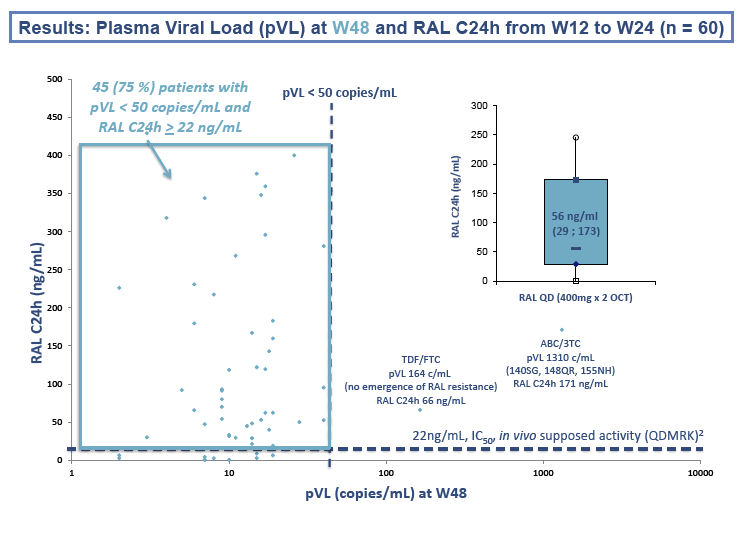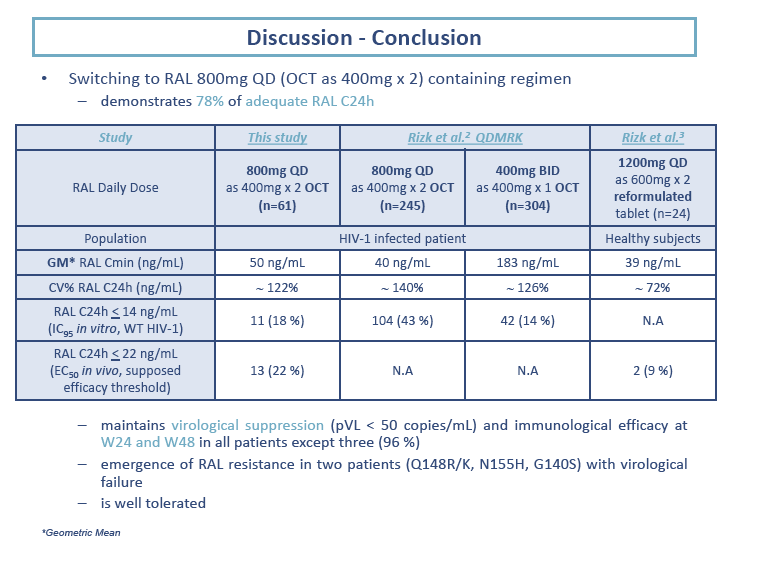 |
 |
 |
| |
Pharmacokinetic of raltegravir (800 mg) once-daily in switching strategies in HIV-1-infected patients with suppressed viremia
|
| |
| |
Reported by Jules Levin
15th International Workshop on Clinical Pharmacology of HIV and Hepatitis Therapy, May 19-21, 2014, Washington, DC
E. Belissa1, F. Caby2, M. Bonmarchand2, C. Soulié3, R. Agher2, R. Tubiana2, M.A. Valantin2, A.G. Marcelin3, C. Katlama2, G. Peytavin1
1Hôpital Bichat-Claude Bernard, Clinical Pharmacology Dpt, Paris, France; 2Hôpital Pitié-Salpêtrière, Infectious Disease Dpt, Paris, France; 3Hôpital Pitié-Salpêtrière, Virology Dpt, Paris, France
Program Abstract:
Background: Raltegravir (RAL) is a first generation integrase inhibitor, active on HIV-1 and HIV-2. RAL metabolism avoids CYP450 pathways and it is preferentially biotransformed by UGT1A1, limiting the occurrence of drug-drug interactions (DDI). RAL Pharmacokinetic demonstrates high between (~212%) and within variability (~122%) and short plasma half-life (~9hours). All this properties bring a twice-daily administration of RAL (400mg BID) for virological efficacy, avoiding the selection of resistant HIV. To improve adherence and quality-life of treated-patient some physicians prescribed RAL in once-daily administration (800mg QD) using the actual approved galenic formulation (poloxamer OCT, Oral Compressed Tablet).
The aim of this study is to evaluate RAL plasma Concentration 24 hours (C24h) after 800mg QD and immune-virological response at week 24 in switching strategies in HIV-1-infected patients with suppressed viremia. Secondary objectives are to describe the impact of inter-patient variability and ARV backbone on RAL pharmacokinetic.
Materials & Methods: multicenter, observational cohort, conducted in HIV-1 infected patients older than 18 years, with plasma Viral Load (pVL) <50copies/mL and a stable antiretroviral (ARV) treatment for at least 6 months, naïve for integrase inhibitors or receiving 400 mg BID without previous history of virological failure on RAL. Written informed consent was obtained from all participants. RAL C24h was measured by UPLC-MS/MS (Waters® Acquity UPLC/Waters® Acquity TQD System) (LOQ<5ng/ml). Statistical analyses were made with StatView® (Abacus Concepts, Berkley, California, USA).
Results: On the 71 enrolled-patients switching for RAL 800mg QD, 17 were pre-treated with 400mg QD, 46 years, 47 males, 15 years since HIV diagnosis, 9 CDC stage C, 588 CD4/mm3, 14 years of ARV duration, 5 previous ARV lines and 62 months on viral suppression. ARV backbone was 42 TDF/FTC, 13 ABC/3TC, 6 ETR, 3 NVP, 3 ATV/r, 1 ATV. Among them, 4 received omeprazole co-medications. Reasons for switching to RAL 800mg QD were: 47 for intolerance, 6 for DDI, 4 for simplification, 15 others. Geometric Mean (CV%) RAL C24h were determined on 61 patients 50ng/mL (122%) with 19% below 14ng/mL (31nM) the in vitro IC95 against HIV1 in 50% human serum (Rizk ML, AAC 2012) and 20% below 22ng/ml (45nM) the in vivo supposed active C24h (lowest quartile of Mean Geometric C24h from QDMrck. At W24, 99% of patients had pVL<50copies/ml and CD4~589/mm3. Apparently, no deleterious impact of ARV backbone had been found. For information, administration of 1200mg QD as 400mg x 3 OCT and 600mg x 2 reformulated tablet in the fasted state resulted in a day 5 geometric mean (CV%) Ctrough of 40ng/ml (53%) and 39ng/ml (72%), respectively (Rizk ML, CROI 2014, Abs. 523).
Conclusions:switching to RAL OCT formulation (800mg QD) containing regimen maintains virological suppression at W24 in all patients except one, with 80% of adequate RAL C24h despite a large inter-patient variability compared with the new formulation at 1200mg QD in healthy subjects.



|
| |
|
 |
 |
|
|